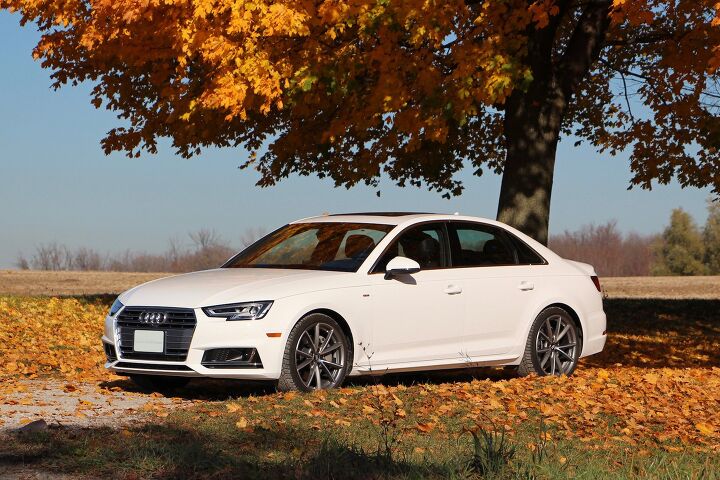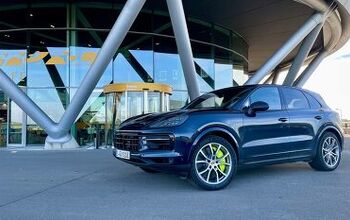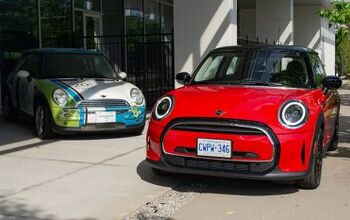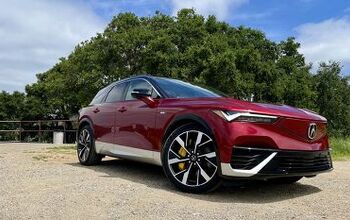2017 Audi A4 Long-Term Test: Introduction

While the automotive marketplace moves frantically toward crossovers of every size, shape and sporting intent, the sedan is not yet forgotten or ignored, especially in the luxury bracket.
For decades now, the BMW 3 Series has dominated the entry level luxury sedan market with its blend of sporting credentials and brand appeal, while Mercedes-Benz’s S-Class was the clear luxury standard at the flagship end. While they didn’t leave a lot of room for competitors, Audi has steadily crept into the conversation as a top-tier luxury brand with steadily improving dynamics, unparalleled interior quality, and a reputation for easily accessible technology.
SEE MORE: 2017 Audi A5 and S5 Review
For generations, the Audi A4 (9th generation, if you’re counting, or B9, if you dig chassis codes) has played third fiddle to the BMW 3 Series and Mercedes C-Class, but the new 2017 A4 has a chance to change all that. We wanted to take an in-depth look beneath the barely-changed skin to see if it has the goods to satisfy the growing legion of Audi faithful and capture the minds and hearts of other luxury shoppers.
We booked it for a long-term test that will span the fall and winter so that we could see Quattro all-wheel drive in its element, test it against some key competitors, and put it through the rigors of family life and city commuting to see how it fares when the initial shine of that new car joy wears off.
ALSO SEE: Where is Audi Made?
Subtle, Significant Updates
But first, let’s cover the basics. For 2017, Audi completely redesigned the A4, though you’d be hard-pressed to tell at first glance, as it merely nipped and tucked the body, with only a few subtle tweaks like headlights, taillights and the grille that really stand out from the previous generation. While the looks are barely altered, they do yield a very impressive 0.27 coefficient of drag, aiding efficiency and reducing wind noise as the air slips over the body.
If we pull out our trusty measuring tape, we can tell you that it is longer and wider, with a longer wheelbase opening up just enough space to start seeming roomy in all but the middle rear seat, which still suffers an elevated seat hump and center tunnel robbing one of head- and legroom. Car seat installation was a breeze, with very accessible anchors and a door that opens wide for easy access, even if it’s not as convenient as a high-riding SUV.
Weight has gone the other way, shedding as much as 100 lb (45 kg) for certain models by virtue of aluminum in the hood and other lightweight materials throughout the body, suspension and even brakes. The A4 can be optioned with either a fixed suspension or one with adaptive dampers, and is fully independent multilink at the front and rear.
FAST FACTS
| Engine: | 2.0-liter four-cylinder turbo |
| Power: | 252 hp; 273 lb-ft of torque |
| Transmission: | 7-speed dual-clutch automated manual |
| Acceleration (0-60 mph): | 5.7 seconds |
| Dimensions (WB/L/W/H): | 111.0/186.1/72.5/56.2 in. (2,819/4,727 /1,841/1,427 mm) |
| Curb Weight: | 3,626 lb. (1,645 kg) |
| Cargo Capacity: | 13.0 cu. ft. (368 L) |
| EPA Fuel Economy (MPG): | 24 city, 31 hwy, 27 combined |
| CAN Fuel Economy (L/100 km): | 9.8 city, 7.6 hwy, 8.6 combined |
| US Price: | Starts at $34,900; $52,950 as tested ($950 freight included) |
| CAN Price: | Starts at $38,500; $59,495 as tested ($2,095 freight included) |
What’s Old is New Again
If you think the powertrain is just the same old 2.0T Quattro, well, it basically is, but with incremental changes that make a world of difference. I own a 10-year-old version of the A4 with, you guessed it, 2.0T Quattro powertrain, so if anyone wants to see us pit the 2017 A4 against its ancestor, let us know in the comments. With a configuration that was ahead of its time by a couple decades in this segment, Audi has had a huge head start developing and refining turbocharged four-cylinder powerplants.
This latest iteration doesn’t necessarily blow the competition away with its power, rated at 252 horsepower and 273 lb-ft of torque, but it’s as smooth and slick as any four-cylinder turbo we can think of, as is the seven-speed dual clutch automatic. it’s good enough to get to 60 mph in less than 6 seconds (0 to 100 km/h in six seconds flat), but it’s the 273 lb-ft of torque available from 1,600 to 4,500 rpm that make it satisfying and rewarding in every situation. We will go a little deeper on the powertrain in our first update to see what Audi did to gain those extra 48 horsepower over the previous generation, as well as some of the tweaks to the legendary Quattro AWD system.
SEE MORE: Audi Q5 Review
Manual transmission fans will be pleased to know that you can choose to row your own in any A4 trim as a no-cost option. However, most owners will likely stick with the ‘S tronic’ dual clutch auto, which is how our test vehicle is equipped.
Efficiency and Pricing
Those that are seeking greater efficiency in an A4 have two front-wheel drive options. The top efficiency option is the Ultra powertrain, a lighter tune of the new 2.0T making 190 hp and 236 lb-ft, which promises a thrifty 37 mpg highway, 27 in the city and 31 combined (8.7/6.4/7.6 L/100 km, respectively). This is also the most economical model in the lineup, starting at $34,900 for the Premium trim with a $950 freight charge ($38,500 in Canada with $2,095 destination fee) or $38,700 for the Premium Plus trim (CAD$42,300).
Some notable standard features on that Premium line are 17-inch wheels, xenon headlights, a rearview camera, power front seats, leather seats, sunroof, Android Auto/Apple CarPlay and a pair of USB ports to which you can easily connect your phone rather than Audi’s proprietary plugs of generations past. Hallelujah. Premium Plus trims upgrade the wheels to 18 inches and add an S-line body kit, LED headlights, heated seats with two memory settings, and a 19-speaker Bang & Olufsen audio system. If you want the Virtual Cockpit system, you have to pony up for the Technology package, which also includes navigation, a wifi hotspot, blind-spot monitoring, and rear-end collision warning.
If you want the full power of the new 2.0T but don’t need the added traction of AWD, you get the same 252 hp and 273 lb-ft as the Quattro models, but slightly better efficiency, coming in rated at 33 mpg highway, 25 in the city and 28 combined (9.4/7.1/8.4 L/100km). This power upgrade costs $2,400 in either Premium or Premium Plus trims and $45,900 for the Prestige, though you can’t get the A4 this way in Canada.
Quattro models are only available with the uprated engine, and return 24 mpg in the city, 31 on the highway, and 27 combined (9.8/7.6/8.7 L/100km), starting at $39,400 in Premium trim, $43,200 for Premium Plus and $48,000 for the Prestige ($43,200/$47,000/$50,600 in Canada).
Pricing can climb even more with notable add-ons like the Advanced Driver Assistance and Sport packages, plus paint, interior finishes and other standalone options. Our car is almost fully loaded, and the Driver Assistance features are many and varied, with new capabilities like Traffic Jam Assist, Turn assist and Exit warning, so we will take a closer look at those in one of our updates. Right out of the gate, I can tell you that Audi’s latest generation adaptive cruise control is top notch, smoothly maintaining a gap, reacting early to very slow traffic in the distance, while proving itself able to bring the car down to a complete stop and picking up speed again if traffic begins moving again within a few seconds.
It’s a promising start, and after a few experiences with Audi’s Virtual Cockpit, we’re looking forward to months of seeing if it stands the test of time, because there is no question that the design and craftsmanship of the interior are impeccable, as usual. The other burning question in our mind is whether the A4’s dynamics are improved enough, with tweaks to suspension and the AWD system, to eclipse those of its luxury rivals.

Jonathan eats, sleeps, and breathes cars. A family man through and through, Jonathan brings over 10 years of experience evaluating cars with a focus on the details that parents will be grateful for, and cars that drivers will appreciate.
More by Jonathan Yarkony

















































Comments
Join the conversation